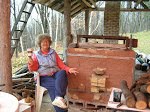As a result of all the trail clearing I got a lot of white pine branches cut into firewood for my wood kiln. In addition I bought a truckload of cedar slabs in June hoping that they would dry a lot faster than any cedar cut this year.
 |
| Wood storage - cedar slabs on the left |
I managed to get this firing in before the end of summer which has been very hot and humid. With all the humidity the shino glazes did not want to do their thing - that is getting that crusty white soda ash look from the soda ash migrating to the surface. To speed up the drying process I had heat-gunned the interior of my tall slab vases and then blocked the tops with plastic bags, thinking this would force the soda to the outside surface. This did not seem to work as little soda ash ended up on the outside surface, much less than normally. Thinking back, heating the interior would really have wicked the soda ash to the inside surface, even if the tops were blocked and the interior could not dry quickly. It would have been better to sweep the heat gun on the outside surface. The test that I had done at MISSA two years ago when I had placed the shinos in different situations - what worked the best was to place the pot in a sunny and windy location and you got great crusting patterns.
Below shows a test to see how ashes affect the cones - both are cone 10 - one was capped by the pot and the other was outside it. It seems like they were equal which is good to know, but maybe the outside cone was not subjected to too much ash where it was placed. I will have to repeat the test in the very front where there is a lot of ash.

 I got some great chuns - on the left Jun 4 over Temmoku turned out a vivid blue/purple and in the front section some super carbon trapping - totally black except where for wax resist brush marks. This was MD shino without the Red Art and it results in more white instead of orange over porcelain. Unfortunately the tall vases ended up mostly an ugly shade of orange brown. I will have to try and refire them in the gas kiln. I am having trouble understanding why one pot gets it while another one next to it hardly any at all.
I got some great chuns - on the left Jun 4 over Temmoku turned out a vivid blue/purple and in the front section some super carbon trapping - totally black except where for wax resist brush marks. This was MD shino without the Red Art and it results in more white instead of orange over porcelain. Unfortunately the tall vases ended up mostly an ugly shade of orange brown. I will have to try and refire them in the gas kiln. I am having trouble understanding why one pot gets it while another one next to it hardly any at all.This time some of the carbon trapping also ended up as even speckling - rather like granular managnese, even where there was applique or lacquer resist/carving that was waxed out. I guess that is what makes shinos so exciting!
I













the work is looking really good
ReplyDeleteBeautiful chun cup and handle
ReplyDelete